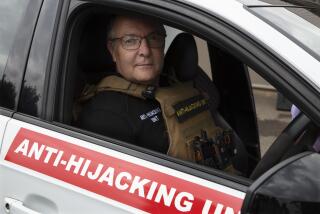Op-Ed: How cop cams can help ordinary citizens

When Amarildo de Souza, an unemployed bricklayer who lived in Rio de Janeiro’s largest favela, left home one evening last July, his intention was simply to pick up a few things at the market. Instead, he was caught up in a drug sweep and taken to the neighborhood police headquarters.
A security camera recorded De Souza’s entry to the station, but he never returned home. For the next two months, his family and friends were left to wonder what had happened — though they had a good idea.
Disappearances and deaths at the hands of the police in Brazil are not unusual. About 35,000 Brazilians have disappeared without a trace since 2007, and Brazilian police are responsible for about 2,000 civilian deaths a year, according to Amnesty International.
Often, the deaths and disappearances go unchallenged, but this time was different. Neighborhood protests gained strength as the weeks passed, and grainy footage of De Souza being escorted into the police station went viral. The phrase “Quem matou Amarildo?” — “Who killed Amarildo?” — was chanted during demonstrations, and it fueled a growing anger toward the so-called pacification police, who had been deployed in Brazilian slums during the lead-up to the World Cup.
And then, two months after De Souza’s disappearance, something unusual happened: 10 police officers were charged with murder and torture in connection with his death. Local newspapers reported that De Souza, who was epileptic, had died during interrogations that featured electric shocks and the placement of a plastic bag over his head. Twenty-two residents from the Rocinha favela have since come forward to report having been tortured by the police.
The charges were, in part, a victory for citizen action. But they were also a victory for technology — the camera proved that De Souza had been in police custody.
In a series of remarkable experiments from New York to Rio de Janeiro, new technologies are proving highly useful in helping to protect ordinary people from arbitrary arrest and extrajudicial violence. Law enforcement agencies have begun employing closed-circuit video, big data detection systems, crowd-sourcing tools and mobile scanners to improve their ability to anticipate, track and prevent crime. And many of these technologies also serve ordinary citizens, by recording the actions of police.
Some police departments, including the LAPD, have mounted video cameras in patrol cars. In other cities, police are wearing body cameras or other recording equipment. And these new technologies have been demonstrated to affect police behavior. The San Bernardino County town of Rialto, for example, saw an 88% reduction in complaints filed against officers and a 60% drop in use of force by police after officers were outfitted with continuously recording body cameras in 2012. And rather than having a chilling effect, the use of body cameras — cop cams — increased positive officer-citizen contact.
Results of the Rialto experiment have been hailed across the country and around the world. A New York judge has ordered the NYPD to begin testing wearable cameras. And in Tucson, where the department ran a 50-camera trial, many officers who were originally opposed to the cop cams have become ardent supporters. Oakland had such success with the cameras it introduced in 2009 that all of its officers now wear them.
Not surprisingly, there has been considerable criticism along the way from police officers and privacy advocates, and they have raised legitimate issues. Crime prevention shouldn’t turn into pervasive surveillance simply for the sake of surveillance. And police need to be able to enter private homes and interview suspects and victims without having them spooked by continuously running cameras.
But these issues can be addressed. The American Civil Liberties Union, for example, has advocated for the inclusion of citizen notification schemes and for limiting filming in people’s homes. They also advise against retaining data for longer than necessary and call for guidelines on the use of recordings, along with some degree of public disclosure.
The long-term success of these tools will depend in large part on public confidence in the integrity of the technology, and it is important to address the concerns of all sides going forward. But without surveillance cameras, the disappearance of Amarildo de Souza would in all likelihood have remained an unsolved mystery, and the men accused of his crime would have never been brought to trial.
Now we must work on putting technology to work to prevent the next such tragedy.
Robert Muggah is research director of the Igarape Institute, a nonprofit think tank based in Brazil. Igarape is developing a free Android app for use by law enforcement that is being tested by Brazilian, Kenyan and South African police.
Follow the Opinion section on Twitter @latimesopinion
More to Read
Start your day right
Sign up for Essential California for news, features and recommendations from the L.A. Times and beyond in your inbox six days a week.
You may occasionally receive promotional content from the Los Angeles Times.






